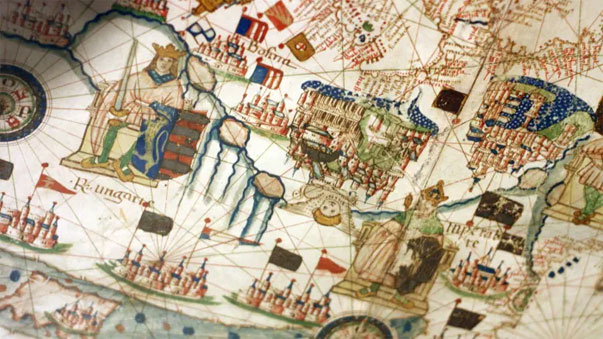|
The Great Cauldron by Marie-Janine
Calic — history of the Balkans
A panoramic
look at the region dispels
preconceptions and restores its
place in Europe
Tony Barber | July 2, 2019 |
Financial Times

At the height of the Bosnian war in 1993 John Major, the UK prime
minister, told the House of Commons that “the biggest single element
behind what has happened in Bosnia is the collapse of the Soviet
Union and of the discipline that that exerted over the ancient
hatreds in the old Yugoslavia”. It was a profoundly misleading
statement. In its reference to supposed “ancient hatreds”, however,
it conformed to a pattern of stereotypical thinking about
southeastern Europe that was at least two centuries old.
In her panoramic and convincingly presented history of the region,
Marie-Janine Calic omits to mention Sir John’s remarks, but she
offers two equally good examples. Edward Gibbon, the 18th-century
historian, asserted near the start of his Decline and Fall of the
Roman empire that Croatia and Bosnia were “still infested by tribes
of barbarians”. Closer to our own day, the novelist Agatha Christie
invented a country called Herzoslovakia, of which she wrote:
“Principal rivers, unknown. Principal mountains, also unknown, but
fairly numerous. Capital, Ekarest. Population, chiefly brigands.
Hobby, assassinating kings and having revolutions.”
The central theme of The Great Cauldron is that southeastern Europe
— Calic mostly avoids the term “Balkans”, pointing out that it is
too often associated with “powder keg” and other pejorative
expressions — has been more intimately connected with the wider
world than understood. Clichés about backwardness and obscure,
unsolvable conflicts miss the point that the region’s ancient Greek,
Roman and medieval Christian origins, not to mention its connections
with modern western culture and politics, make the area part of a
common European civilisation.
As professor of eastern and southeastern European history at Ludwig
Maximilian University in Munich, Calic is an authoritative guide.
Her book is a work of ambitious chronological and thematic scope,
taking the story from Alexander the Great to the present day.
She is well qualified to discuss the 1990s wars of the Yugoslav
succession, having worked for the international tribunal in The
Hague that investigated war crimes and other atrocities committed in
those conflicts. Her conclusion is unambiguous: “Mass crimes were
overwhelmingly ordered by higher authorities; they were not driven
primarily by the ethnic hatred of neighbours against neighbours.”
Throughout The Great Cauldron Calic draws attention to the
interaction between southeastern Europe and the western world. In
1776, the Comte de Choiseul-Gouffier, a future French ambassador to
the Ottoman Empire, visited a Greek Orthodox monastery on the island
of Patmos and was astounded to hear the first question from a local
monk: “Is Voltaire still living?”
In Romania, after the outbreak of the US civil war in 1861, “boyars,
soldiers, priests, intellectuals and educated ladies read the
translation of Uncle Tom’s Cabin”, finding in the push to abolish
slavery in the US a model for the cause of social reform at home.
Likewise, Jovan Skerlic, an early 20th-century Serbian literary
theorist, wrote that the choice facing his region was “either to
accept western culture and live, as the Japanese have done, or to
oppose it and be overrun, as has happened to the American Indians
and Australian aborigines”.
In Calic’s view, the region slowly diverged from western Europe in
the 17th and 18th centuries, when the world economy’s centre of
gravity shifted to the Atlantic. The mainly agrarian societies of
southeastern Europe, living under an Ottoman system that fell into
relentless decline, were on the periphery of the new global trading
networks and the arrival of industrialisation.
Modern nationalism was, in a sense, a curse for the Balkans. Between
the French revolution and the first world war, the region’s peoples
came increasingly to think of themselves as belonging to specific
nations rather than being simply Catholics, Orthodox or Muslims.
Unfortunately, “since clear geographic and ethnic boundaries existed
neither in the past nor in the present, conflicts among the national
movements were foreordained”.
Some of the best passages of Calic’s book are her vivid
reconstructions of daily life in the region’s big cities and ports,
such as Istanbul, Dubrovnik, Thessaloniki, Plovdiv, Belgrade and
Sarajevo. She also includes lively sketches of characters such as
Skanderbeg, the 15th-century Albanian hero (well known to western
Europeans in his day), and Ivan Dominik Stratiko, the progressive
Croatian bishop.
Calic ends with a touch of optimism: the region’s post-communist
states appear on course to join the EU, and “the Balkan countries
are in no way fated to remain in the poorhouse of Europe”. But she
is realistic, too. “Today state- and nation-building in the former
Yugoslavia is not yet finished, and numerous questions of identity,
borders and status remain unresolved.” |